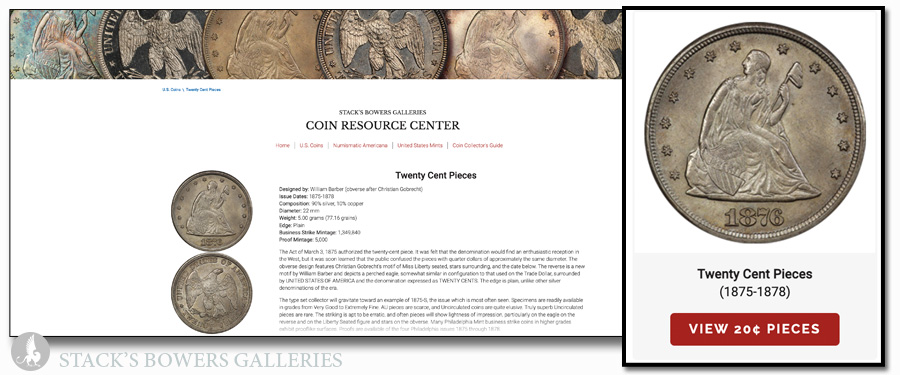
The twenty-cent piece (or double dime) was a short-lived series introduced in the 1870s in an effort to more fully decimalize U.S. coinage and, probably, provide a market for Western silver.
Proposals for a twenty-cent piece were in the air in the late 18th century but legislative efforts to authorize this denomination did not materialize until the early 1800s. Realization of these initiatives would take decades with sporadic efforts in the century’s first decade, as well as the 1850s. Legislation was introduced in the early 1870s and a bill authorizing the denomination was signed into law in March 1875. Much of the agitation for the denomination in the late 19th century originated in California, where merchants frustrated by the difficulty of transactions with 12.5-cent increments advocated for the abolition of the quarter and the adoption of a 20-cent piece. These difficulties harkened back to discussions about the merits of a fully decimalized monetary system that originated in the 1780s. Some observers at the time perceived the double dime authorization as an effort on the part of politicians from silver-producing Western states to favor a local industry, especially after the Coinage Act of 1873 eliminated silver dollars.
Our CRC entry on the series and the discussions of each date cover this history in much greater detail.
The design for the new denomination was cobbled together from motifs on existing U.S. coins. The Seated Liberty motif for the obverse was appropriated, with some minor changes, from the existing dime through half dollar and the eagle on the reverse adopted from the trade dollar.
The coins proved unpopular in circulation, owing at least in part to their similarity in size and appearance to the quarter – a fate which would befall the Susan B. Anthony dollar just over a century later. By 1876 it was clear that the coins would not gain widespread acceptance and the last two dates of the series, 1877 and 1878, were Proof-only issues. Resistance culminated in May 1878 when President Rutherford B. Hayes signed legislation abolishing the denomination. Its short life and limited production mean that many of the dates for twenty-cent pieces are scarce and the 1876-CC is very rare.
Our Coin Resource Center entries on twenty-cent pieces are structured similarly to entries on other series. A history of the series appears on one page with links to entries covering individual dates at the bottom; each date entry includes histories and analyses of collectability and rarity and links to recent auction results and Coins in Motions animations, where available. Entries covering all the series’ dates are included at time of writing.





